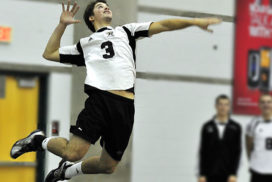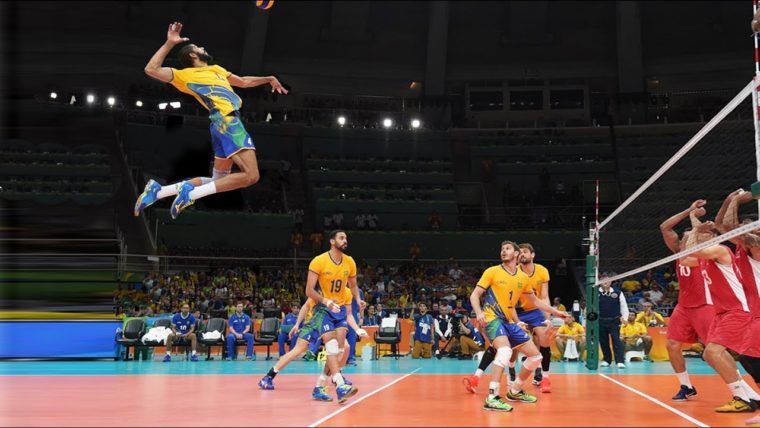How to Spike a Volleyball
To learn how to spike a volleyball, you must first learn the volleyball basics. A volleyball spike begins with a solid approach. The best FIVB and Olympic volleyball hitters in the world make smashing a volleyball down the line look easy which is only made possible by perfecting a fluid routine. Being in the right place at the right time will enable you to capitalize on your opportunities and is absolutely vital to the development of your volleyball skills. A great way to learn different aspects of the game is to watch as many volleyball videos as possible. Let's start by taking a quick look at the volleyball footwork associated with the 4 step approach.
Volleyball Spike: Where to Start on the Volleyball Court
The first thing you are going to want to do is find a location on the volleyball court (behind the 10 foot line) that you are comfortable with in terms of beginning your volleyball approach. This will be determined by how long your approach typically is as well as what position you are playing.
Outside Hitter
Begin your hitting approach behind the 10 foot line on the left side of the volleyball court. Take your first step to the left so you can create a rounded “out-to-in” path finishing just inside of the volleyball antenna. This will allow you to attack the volleyball at an angle or turn your shoulders and hit down the line.
Middle Hitter
The starting position for the Middle Hitter depends heavily on where the volleyball pass ends up. Do your best to begin your hitting approach behind the 10 foot line just to the left of the setter.
Opposite Hitter
Start your hitting approach behind the 10 foot line to the right of the volleyball court. Take your first step directly towards the volleyball net creating a straight path that finishes just inside the antenna.
Volleyball Spike: Watching the Setter
Watch the setter from the point the volleyball is passed to the point the volleyball leaves the setter’s hands. Volleyball court awareness is incredibly important and dictates everything from where you should be at any given point of your attack, to the timing of your volleyball hitting approach.
Pin Hitters
What you are running will dictate when you should begin your approach. If you are an outside running a four set or an opposite running a 5 set, you should track the pass and begin your approach just prior to the ball reaching the setter. This enables you to be prepared if the pass is off of the volleyball net therefore causing some last second adjustments.
Middle Hitter
If you are running a quick set, you should begin you approach just after the ball is passed. Track the pass and run towards the area in which the setter will be. Jump prior to the ball being set and begin your swing as the ball is in the setter’s hands.
Volleyball Spike Approach
The two types of volleyball approaches seen most often are the 3 step approach and the 4 step approach. The 3 step approach is usually used during a quicker attack such as a one ball for the middle hitter or a shoot for the outside. The 4 step approach is essentially the same as the 3 step approach but has an added short step in the beginning that acts as a guide. Either can be used in any situation and ultimately depends on the volleyball hitter’s preference. When you're first starting out, don't worry too much about looking like your favorite professional volleyball players. Do the approach that you are comfortable with so you can quickly enhance your game.
4 Step Approach (as seen in volleyball video above)
For right handed hitters, begin your approach with a small step with your right foot. Your second step is going to be bigger and faster with your arms slightly ahead of your body. The third step is the largest and most powerful and your arms swing back behind you (furthest when your right heel touches the ground). Your final step is quick as your arms explode forward thus helping propel you off of the ground.
3 Step Approach (as seen in volleyball video below)
For right handed hitters, start your approach with a short step with your left foot. Your second step is with the right foot and is long and explosive ending with your arms behind you as shown in the video below. Your final step is quick and is accompanied by a rapid arm swing to help propel you off of the ground.
Volleyball Spike: Making Contact
The best place for the ball to be when hitting is in front of your head and to the right of your ear. You will want to make contact with your arm fully extended thus creating the most power possible.
Midair Volleyball Spike Tips
 Once you are airborne, use your guide hand (left hand for a right handed hitter) to help get you as high as possible so you can create as much torque as possible on your follow through. Pull back your swinging hand in a “bow and arrow” fashion to create the volleyball image seen to the right. If you play beach volleyball, you will notice how similar this form is to the avp volleyball logo. Once the ball is in the correct position, constrict your core and swing your arm forward to create a powerful attack.
Once you are airborne, use your guide hand (left hand for a right handed hitter) to help get you as high as possible so you can create as much torque as possible on your follow through. Pull back your swinging hand in a “bow and arrow” fashion to create the volleyball image seen to the right. If you play beach volleyball, you will notice how similar this form is to the avp volleyball logo. Once the ball is in the correct position, constrict your core and swing your arm forward to create a powerful attack.
Finish the Attack
Snap your wrist down on an attack to create forward spin on the ball. One of the best volleyball quotes from famous volleyball player Danny Kinda is, “Don’t be afraid to show the snap”. Beginner volleyball players often forget to snap their wrists which ultimately leads to volleyball spikes sailing out of play. Watch NCAA Volleyball coach Terry further explain some of the volleyball techniques mentioned above.
Practice makes perfect! The best thing you can do for yourself is make the entire motion of hitting a volleyball become second nature. Get your approach down and move on to timing with your setter. It is important to note that volleyball injuries happen quite frequently while hitting and blocking. Learn to control your body as best as you can and do yourself a favor and get some Mizuno Ankle Braces. They carry them at most sporting goods stores but are cheapest on Amazon (click link above)!
